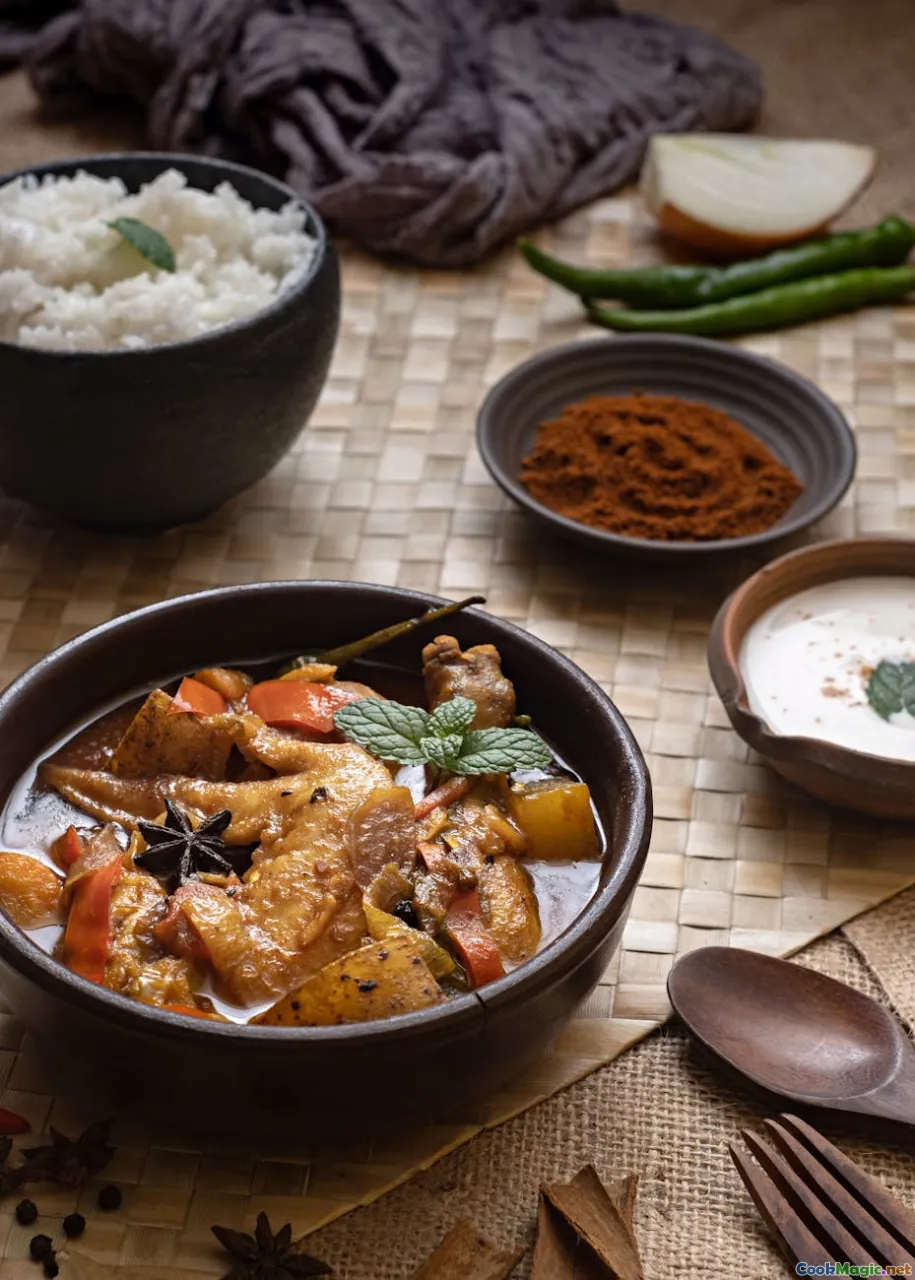Southeast Asian Stews with Coconut Milk
8 min read Discover the rich flavors, cultural significance, and vibrant aromas of Southeast Asian stews infused with creamy coconut milk, a culinary treasure. April 21, 2025 23:55
Southeast Asian Stews with Coconut Milk
Imagine walking through a bustling street market in Bangkok, a fragrant breeze carrying the aroma of simmering spices, with the promise of a hearty, soul-warming stew awaiting you. Or picture a quiet evening in a Balinese home, where a pot of coconut milk-based stew bubbles softly, infused with local herbs and tender meats or vegetables. These sensory experiences are at the heart of Southeast Asian cuisine—a vibrant tapestry woven with bold flavors, fragrant spices, and the comforting embrace of coconut milk.
An Introduction to Southeast Asian Coconut Stews
Southeast Asia is renowned for its diverse culinary landscape, where coconut milk acts as a unifying ingredient across many traditional dishes. These stews are more than just food; they are cultural expressions, stories of history, geography, and community woven into every simmering pot. The use of coconut milk transforms ordinary ingredients into velvety, fragrant masterpieces that balance spice, sweetness, acidity, and umami.
From Thailand’s rich curries to Indonesian rendangs and Filipino stews, the coconut milk-infused dishes are emblematic of the region's love for bold, layered flavors. Each country, each village, offers its own variation—adding personal touches, specific herbs, or local ingredients—making these stews a reflection of local identity.
Historical and Cultural Significance
Coconut trees, often called the "Tree of Life," have been cultivated in Southeast Asia for thousands of years. Their versatility—providing food, oil, fiber, and building materials—made them central to the livelihood and culinary traditions of coastal communities.
Stews utilizing coconut milk emerged as a practical way to enrich humble ingredients, preserving nutrients and flavor in a tropical climate. Over centuries, these dishes evolved, influenced by trade routes, colonization, and cultural exchanges, resulting in a rich culinary heritage.
In places like Thailand and Malaysia, these stews are often associated with family gatherings and festive occasions. They symbolize warmth, hospitality, and the sharing of stories around the dinner table.
The Sensory Experience: Taste, Aroma, and Texture
Imagine the first spoonful: a luscious, velvety sauce enveloping tender chunks of chicken, beef, fish, or an array of vegetables. The aroma is intoxicating—a symphony of spices such as turmeric, lemongrass, galangal, and kaffir lime leaves mingling with the sweet, nutty scent of coconut milk.
The flavor profile is complex: a gentle sweetness balances the heat of chili, acidity from lime or tamarind cuts through richness, and fresh herbs add brightness. Texturally, the stew offers a delightful contrast—creamy yet hearty, with ingredients that are soft yet retaining a pleasant bite.
Iconic Southeast Asian Coconut Milk Stews
Thai Green and Red Curry
Thailand’s iconic curries are perhaps the most recognizable coconut milk stews globally. The rich green or red paste—made from chilies, garlic, lemongrass, and other aromatic herbs—melds with coconut milk to create a vibrant, flavorful sauce. Chicken, beef, fish, or even vegetables simmer in this fragrant broth, absorbing every nuance of flavor.
Indonesian Rendang
Rendang is a slow-cooked beef stew from West Sumatra, simmered in coconut milk and a spice blend called "rempah." This dish is a labor of love, as it takes hours to achieve the perfect tender meat infused with complex spices and a deep caramelized richness.
Filipino Bicol Express
A spicy, coconut milk-based stew originating from the Bicol region, known for its bold flavors. It combines pork, shrimp, or vegetables with chili, garlic, and ginger, simmered in coconut milk until thick and fragrant.
Malaysian Assam Pedas
While primarily known for its tangy tamarind flavor, many Malaysian stews incorporate coconut milk to balance acidity with creaminess, creating a harmonious blend of flavors.
Cooking Techniques and Tips
- Layering Flavors: Start with sautéing aromatics like garlic, shallots, and spices, then add proteins or vegetables, followed by coconut milk. This builds depth.
- Slow Simmering: Many stews benefit from gentle, slow cooking to tenderize ingredients and allow flavors to meld.
- Balancing Spices: Adjust chili and herbs to suit personal heat tolerance, adding lime or tamarind for acidity and sweetness as needed.
- Quality Coconut Milk: Use good-quality, preferably fresh or organic coconut milk for richer flavor and better texture.
Personal Reflections and Cultural Insights
Having traveled extensively across Southeast Asia, I’ve always been captivated by how these stews are more than just food—they are stories on a plate. In a small village in Bali, I watched a family prepare a coconut-based stew over an open fire, sharing laughter and local tales that seemed to infuse the dish itself.
In Bangkok’s street markets, vendors simmer pots of green curry with a skillful hand, their use of fresh herbs and spices elevating the humble ingredients into culinary art. These dishes evoke a sense of community, tradition, and resilience—testaments to generations of cooks who have perfected the craft.
Conclusion: Embracing the Comfort of Southeast Asian Coconut Stews
Southeast Asian stews with coconut milk are more than delicious recipes—they are cultural treasures, imbued with history, emotion, and identity. Whether you’re savoring a spicy Thai curry, a slow-cooked Indonesian rendang, or a fiery Filipino Bicol Express, you’re partaking in a tradition that celebrates the richness of life, community, and flavor.
So, next time you reach for a can of coconut milk, think beyond the mundane. Imagine the stories, the aromas, and the vibrant colors it can bring to your table. With a little patience and a dash of curiosity, you too can create these soulful stews, bringing a taste of Southeast Asia into your home—and perhaps, into your heart.









